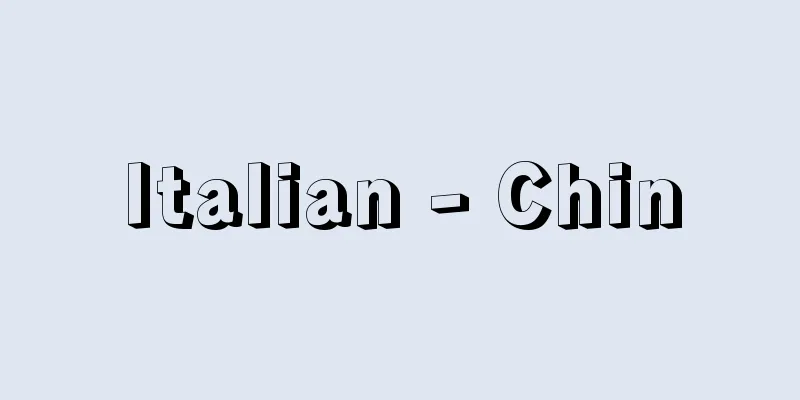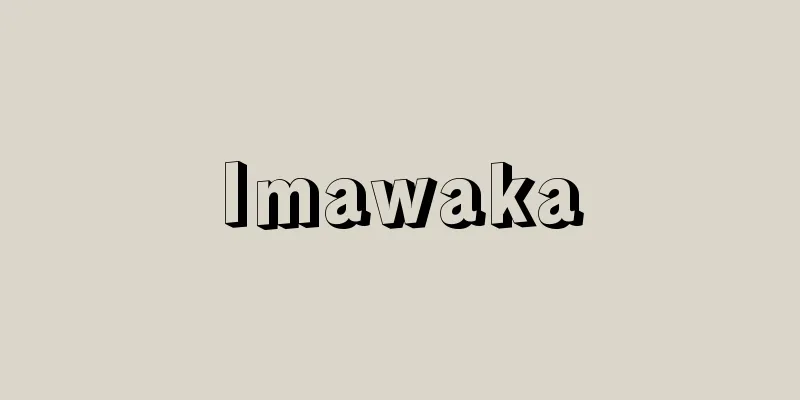Italian - Chin

|
It is spoken in southern Western Europe, in the Italian peninsula jutting out into the Mediterranean Sea, in Sicily, Sardinia, the Lugano region of southern Switzerland, the French island of Corsica, and the Istria region of Croatia. It has a speaking population of approximately 60 million. [Koji Nishimoto] FeaturesVerb conjugations (person, number, tense, mood) are complex, allowing for detailed expression. Nouns and adjectives can be gendered and singular or plural (there are no case conjugations). Because word forms are clearly conjugated, subject pronouns are not normally used, and word order is relatively free. Phonetically, it is the easiest of all Western European languages to adopt from Japanese, for reasons such as the fact that the vowels are almost identical to the Japanese a-i-u-e-o sounds, and that it has many open syllables. [Koji Nishimoto] historyItalian is one of the languages known as Neo-Latin or Romance languages. In other words, it is one of the languages that arose in the Mediterranean coastal areas of Western Europe between the collapse of the ancient Roman Empire, which had risen in Italy and occupied a vast territory throughout the Mediterranean region, at the end of the 5th century, and the establishment of a new European order around 1000 AD. These languages are roughly divided into five languages: Portugal, Spain, France, and Italy from the west, and Romania, the language of an ancient Roman colony, far to the east. All of them have Latin as their base, and they have been mixed with the languages of the indigenous peoples of each region and the languages of peoples who invaded later, and have finally acquired characteristics that can be considered independent languages. Italian, along with Romanian, belongs to the eastern group of Romance languages, and this characteristic is particularly evident in the change in the number of nouns. In the western group (French, Spanish, Portuguese, etc.), the plural form of nouns is expressed by the accusative (direct object) plural form of the proto-Latin, and the singular form is made plural by adding an (s) to the end. In contrast, the eastern group uses the nominative plural form of Latin nouns, and the final vowel is changed to make the plural (un libr o →due libr i , una cas a →due cas e ). It is impossible to determine when Italian separated from the original Latin, but the oldest known written sources in Italian are the "Mysteries of Verona," a pair of vague lines of writing left by a scribe in the margin of a Latin prayer book in the early 9th century, and the testimony of an illiterate peasant and a monk, quoted in a legal document, also entirely in Latin, concerning the property of the monastery of Monte Cassino in 960. The latter was a faithful transcription of the words of witnesses appearing in court by a court clerk who was competent enough to write Latin to accurately record the progress of the trial.From the Latin point of view, the spoken language of the people at this stage had taken on a corrupted appearance that could no longer be called Latin.At the same time, from the Italian point of view, this unintentionally showed the early signs of Italian moving away from its parent language Latin and beginning to develop into an independent language. The date of 960 is more than a century later than the first document "The Oath of Strasbourg" (842) in French, one of the most important Romance languages along with Italian. This is because, unlike Gaul (France), which was a remote area beyond the Alps in the ancient Roman Empire and inhabited by the Celts as its indigenous people and the Franks as its later invaders from the end of the Roman Empire, Italy was the former land of the Roman Empire and, although it declined, the breath of Latin culture never completely disappeared throughout the Middle Ages, so the power of Latin was strong and it took time for the separation. Of course, 842 for French and 960 for Italian are only the oldest written documents currently known, and it is easy to surmise that the use of local languages that are no longer Latin among the general public probably dates back to even earlier. Thus, Italian, which was established around 1000 AD, was one step behind French and especially Provençale, which developed in southern France, in terms of maturity as a means of cultural expression. However, when it emerged in the second half of the 13th century as a language with a sophistication that could withstand literary expression, it played a remarkable role as a means of expression of the civil culture that characterizes Western European civilization to this day, earlier than any other European language. Needless to say, factors such as the cultural heritage of ancient Rome, the geographical advantage of being located at the junction of the Eastern and Western Mediterranean and the junction of the Islamic and Christian religious spheres, contact with the Eastern Roman Empire, and a geographical location blessed with seaports were at work in this regard. These factors made it possible for the establishment of city-states in Italy that allowed civil culture to flourish, ahead of other parts of Europe. Then, from the end of the 13th century to the 14th century, with the emergence of the three great writers Dante, Petrarch, and Boccaccio in central Italy, especially in the Tuscany region, the Tuscan dialect established its position as a standard and literary language, and this situation has remained essentially unchanged since then. Therefore, if one acquires knowledge of modern Italian, and becomes accustomed to some older forms and expressions, one can read documents dating back to the end of the 13th century. Italian is the only Western language that allows this, since in other countries the transition from the Middle Ages to the Modern Era took place in the late 15th and 16th centuries. However, the fact that a local language became the standard language used by a relatively small number of intellectuals and upper classes among the entire population and that it maintained an almost identical form for six centuries, and that it arose among individualistic people in a country that tended to be divided into small independent regions by mountain ranges that ran across the peninsula and extended close to the coast, even before the development of transportation and information transmission methods, led to the development of a large number of dialects throughout Italy. The differences between these dialects are very large, and even today there are still cases where people from different regions cannot understand each other. There also emerged writers who asserted the unique value of dialects and wrote literature in dialects. Overall, however, the issue of standard and dialectal languages in Italian entered a new stage in the 20th century due to the reform of the school system, the development of transportation such as railways and highways, the establishment of national-scale governance such as conscription and bureaucratic organizations, and the spread of mass media, especially radio and television. [Koji Nishimoto] Influence on foreign languagesDuring the so-called Renaissance period, from the 14th to the 16th centuries, Italian led Western Europe in all fields of human activity. This is evident from the names of Ariosto and Tasso in literature, Machiavelli, Guicciardini, and Lorenzo de' Medici (Il Magnifico) in politics, Raphael and Michelangelo in art, and Galilei and Torricelli in science. Furthermore, half of Shakespeare's works are set in Italy. Italy is also the birthplace of opera, which was completed in the 18th century, and until the birth of national opera in the 19th century, Italian was used in works by composers other than Italians, as seen in the works of Mozart. Most musical terms are Italian, and Italian has had a great influence on Western culture. [Koji Nishimoto] "B. Migliorini, I. Baldelli, Breve storia della lingua italiana (1965, Sansoni, Firenze)" ▽ "S. Battaglia, V. Pernicone, Grammatica italiana (1964, Loescher, Torino)" ▽ "Modern Italian" by Koji Nishimoto (1978, Sanseido) ▽ "Introduction to Italian" by Tetsuo Sakamoto (1974, Hakusuisha) Source: Shogakukan Encyclopedia Nipponica About Encyclopedia Nipponica Information | Legend |
|
西ヨーロッパ南部、地中海に突き出たイタリア半島、シチリア島、サルデーニャ島、およびスイス南部ルガノ地方、それに現在フランス領のコルシカ島、クロアチアのイストリア地方などで話されている言語。使用人口は約6000万である。 [西本晃二] 特徴動詞の変化(人称・数・時制・法)が複雑で、これによってきめ細かい表現を行う。名詞・形容詞には男女・単複の変化がある(格変化はない)。語形の変化がはっきりしているので、普通、主語代名詞は用いられず、語順も比較的自由である。音声的には、母音が日本語のアイウエオでほぼまにあう、開音節が多いなどの理由で、西ヨーロッパの言語のうちで日本語からもっとも入りやすい。 [西本晃二] 歴史イタリア語はネオ(新)ラテン語あるいはロマンス語とよばれる言語の一つである。すなわち、かつてイタリアの地に興り、地中海域全体に広がる広大な版図を占めた古代ローマ帝国が5世紀末に崩壊し、その後新しいヨーロッパの秩序が成立する西暦1000年ごろまでの間に、現在の西ヨーロッパ地中海沿岸地域に発生した言語の一つである。これらの言語には、大まかにいって西からポルトガル、スペイン、フランス、イタリア、それに遠く東に、古代ローマ植民地のことばであるルーマニアの五つの言語がある。いずれもラテン語を母体とし、それに地方地方の先住民や、あとから侵入してきた民族のことばが入り混じって、ついに互いに独立の言語とみなしうる特色を備えるに至った。 イタリア語は、ルーマニア語とともにロマンス諸語のなかでは東のグループに属しており、その特徴は名詞の数変化にとくに明らかである。すなわち西のグループ(フランス、スペイン、ポルトガル語など)では、名詞の複数形を表すのに、祖語であるラテン語の対格(直接目的格)複数形を採用し、単数形の語尾に(s)を加えて複数形とする。これに対し東のグループでは、ラテン語名詞の主格複数形をとり、語末の母音が変化して複数形をつくる(un libro→due libri, una casa→due case)。 イタリア語がいつごろ祖語のラテン語から分離したかを決めることはとうていできない。しかし、書かれた形で残っているイタリア語資料の最古のものとしては、9世紀初めに「ベローナの謎(なぞ)うた」とよばれ、ラテン語の祈祷書(きとうしょ)の余白に、写字生によって書き残された2行ばかりの、あまり意味のはっきりしない落書き(したがってイタリア語かどうかも明白ではない)、および960年にモンテ・カッシーノ修道院所有地に関する、これも全体はラテン語の訴訟記録中に引用されている無学な農夫と下級僧侶(そうりょ)の証言、の二つがある。後者は、十分にラテン語を書く能力を有する裁判所の書記が裁判進行の状況を正確に記録するため、証人として出廷した人物の発言をできるだけ忠実に音写したもので、ここに至って民衆の話しことばは、ラテン語の立場からすれば、どうみてもラテン語といえぬ崩れた様相を呈しており、それが同時にイタリア語側からすれば、祖語のラテン語から離れて、独立の言語として歩み始めた初期の姿を図らずも示しているということになる。 960年という時期は、イタリア語と並んで有力なロマンス語の一つフランス語の初出文献「ストラスブールの宣誓」(842)に比べて1世紀あまりも遅れている。これは、古代ローマ帝国のなかではアルプスのかなたの辺境であり、かつ先住民族としてはケルト人、あとからの侵入者としてはフランク人がローマ帝国末期から定住していたガリア(フランス)と異なり、イタリアはローマ帝国の故地で、衰えたりとはいえ、中世全体を通じてラテン文化の息吹が完全に絶えたことは一度もなかったため、ラテン語の力が強く、分離に時間がかかったということであろう。むろんフランス語の842年、イタリア語の960年といい、書かれた資料の、それも現在知られている最古のものというだけのことで、実際に民衆の間ではもはやラテン語とはいえぬ、その地方独特のことばが用いられ始めたのは、さらに以前にさかのぼるであろうことは、容易に推察される。 こうして西暦1000年前後に成立したイタリア語は、文化の表現手段としての成熟度においても、フランス語、とくに南フランスに発達したプロバンサル語に一歩遅れる。しかし、13世紀後半に至って文学的表現に耐えうる洗練さを備えた言語として登場してきたときには、他のヨーロッパ諸語のどれよりも早く、西欧文明を今日に至るまで特徴づけている市民文化の表現手段として目覚ましい活躍をすることになる。これには古代ローマの文化遺産、東西両地中海の接点とイスラム・キリスト両宗教圏の接点に位置するという地理的利点、東ローマ帝国との接触、海港に恵まれた地形などの要素が働いていることはいうまでもない。これらの要素がヨーロッパの他の地域に先駆けて、イタリアに市民文化の花を咲かせる都市国家の成立を可能にしたのである。そして、13世紀の終わりから14世紀にかけて、中部イタリア、とくにトスカナ地方でダンテ、ペトラルカ、ボッカチオの三大作家の出現をみて、トスカナ方言は標準語・文学語としての地位を確立し、以後今日までこの状況は実質的に変わっていない。したがって、現代イタリア語の知識を身につければ、あとは多少の古い形や言い回しに慣れれば、13世紀末あたりまでの文献を読むことができる。かようなことが可能なことばは、西欧の言語ではイタリア語以外にはない。けだし他の諸国では、中世から近代への転換が、15世紀末から16世紀におこっているからである。 だが、一地方のことばが、このように国民全体のなかでは比較的少数の知識人や上流階級が用いる標準語となり、それが6世紀にもわたってほぼ同一の形を保ってきたというような状況、かつそれが交通や情報伝達の手段がいまだ発達しないころから、半島を縦断し、海岸近くまで張り出した山脈によって相互に独立した小地域に分かれる傾向の強い国土に、個人主義的気質をもつ人々の間に発生したということ、この二つの理由によって、イタリア各地に多数の方言をも発生させた。その相互間の違いはたいへん大きく、地域が異なれば話が通じないという場合が今日でもままある。また、方言独自の価値を主張し、方言で文学作品を書く作家も現れた。しかし、全体的にみれば、学校制度の改革、鉄道や高速道路など交通手段の発達、徴兵制度や官僚機構など全国的規模の統治方式の整備、そしてとくにラジオ、テレビに代表されるマス・メディアの普及によって、イタリア語における標準語と方言の問題は、20世紀に入って新しい段階を迎えたといえる。 [西本晃二] 外国語への影響14世紀から16世紀にわたる、いわゆるルネサンスの時代に、イタリア語は人間活動のあらゆる分野で西ヨーロッパをリードした。文学では前記三大作家のほかにアリオストやタッソ、政治ではマキャベッリ、グイッチャルディーニ、ロレンツォ・デ・メディチ(イル・マニフィコ)、芸術のラファエッロ、ミケランジェロ、科学のガリレイ、トリチェリなどの名をみれば、このことが知られる。さらに、シェークスピアの作品の半分はイタリアを舞台にしている。また、18世紀に完成したオペラもイタリアを発祥の地としており、19世紀国民オペラ誕生までは、モーツァルトの作品にみられるように、イタリア人以外の作曲家の作品にもイタリア語が用いられた。音楽用語のほとんどがイタリア語であり、西欧文化に与えた影響は大きい。 [西本晃二] 『B. Migliorini, I. BaldelliBreve storia della lingua italiana(1965, Sansoni, Firenze)』▽『S. Battaglia, V. PerniconeGrammatica italiana(1964, Loescher, Torino)』▽『西本晃二著『現代のイタリア語』(1978・三省堂)』▽『坂本鉄男著『イタリア語の入門』(1974・白水社)』 出典 小学館 日本大百科全書(ニッポニカ)日本大百科全書(ニッポニカ)について 情報 | 凡例 |
<<: Italian Policy - Italianpolitik (English spelling) German
>>: Italian String Quartet (English: Quartetto Italiano)
Recommend
Art of the Azuchi-Momoyama period
In political history, the Momoyama period lasted f...
Stilb
CGS unit of luminance. Symbol sb. In the Internati...
Winning Sumo Ukinahanabure - Kachizumo Ukinahanabure
Kabuki kyogen. Sewamono. 4 acts. Written by Tsuruy...
Fisheries Adjustment Committee - Gyogyouchoseiinkai
It is one of the administrative committees establ...
Katsuragibe
...In the Kojiki and Nihon Shoki, the "shi-s...
Stumpf - Carl Stumpf
German psychologist. Born near Würzburg, he loved...
My Tho
The capital of Tien Giang Province in southern Vie...
control survey
… Surveys are classified according to their purpo...
Community psychiatry
It is a new field of psychiatry that emerged after...
Dancer of Izu - Izu no Odoriko
An early short story by Kawabata Yasunari. Publis...
Matsuura River
A river in northern Saga Prefecture. It flows int...
Hinoshi Kaisan - Hinoshi Kaisan
A person who is unrivaled in the world, or an out...
Fanny Lewald-Stahr
1811‐89 A German female writer who advocated women...
Izumoji Temple
[1] A temple located in Izumoji , Otagi County, Ya...
Treaty of Kiel
On January 14, 1814, in Kiel (now Germany), a Dan...



![Kitakata [city] - Kitakata](/upload/images/67cb530de3dfe.webp)





